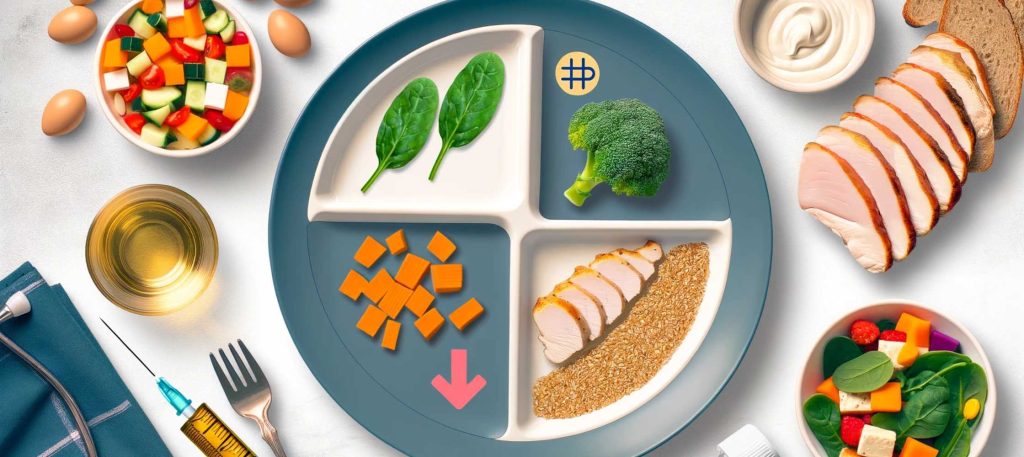|
Getting your Trinity Audio player ready...
|

In the realm of type 2 diabetes management, the intersection of medication and diet holds a pivotal role in controlling blood sugar levels and enhancing overall well-being. Trulicity (dulaglutide), a once-weekly injectable therapy, has emerged as a key player in this landscape, offering a modest decrease in A1C levels with minimal risk of severe hypoglycemia.
As we delve into the topic of “Foods to Avoid with Trulicity,” it’s essential to highlight the significance of tailored dietary choices that complement the medication’s benefits while minimizing potential risks.
Recent data underscore the critical nature of managing type 2 diabetes, not just through medication but also through lifestyle changes, including diet. With type 2 diabetes affecting a significant portion of the population, understanding how to optimize treatment with Trulicity through dietary adjustments is more relevant than ever.
Understanding Trulicity and Nutrition
Trulicity works by mimicking the GLP-1 hormone, which helps lower blood sugar levels by stimulating insulin release, reducing the liver’s sugar production, and slowing gastric emptying.
This multifaceted approach not only aids in managing blood sugar levels but also has a side benefit of weight loss for many patients. Given this mechanism of action, the interplay between Trulicity and dietary intake becomes a critical consideration for users of the medication.
Major Foods to Avoid or Limit
1. High-Sugar Foods and Beverages
High-sugar foods can lead to spikes in blood sugar levels, which are precisely what Trulicity aims to manage. It’s advisable to limit or avoid sugary drinks, candies, and desserts that can counteract the benefits of the medication.
2. Refined Carbohydrates
Foods made from refined carbohydrates, such as white bread and pastries, can also cause quick increases in blood sugar levels. Opting for whole grains, which have a lower glycemic index, can help maintain more stable blood sugar levels.
3. High-Fat Foods
Saturated and trans fats found in fried foods, full-fat dairy products, and fatty cuts of meat can adversely affect heart health, a critical concern for those with diabetes. Healthier fats, such as those from fish, nuts, and olive oil, should be prioritized.
4. Alcohol
Alcohol can have unpredictable effects on blood sugar levels. For individuals taking Trulicity, it’s essential to consume alcohol in moderation or follow healthcare provider advice on whether it should be avoided entirely.
5. Processed Foods and Fast Foods
These often contain high levels of added sugars, unhealthy fats, and salt, all of which can complicate diabetes management and overall health. Emphasizing fresh, whole foods can support better blood sugar control and health outcomes.
Tips for a Trulicity-Friendly Diet
Maintaining a balanced diet is crucial for enhancing Trulicity’s effectiveness and overall health. Here are key considerations and actionable tips for navigating your diet while on Trulicity:
- Embrace a Balanced Plate: Fill half of your plate with non-starchy vegetables like leafy greens, a quarter with high-quality protein such as lean meats, fish, or legumes, and the remaining quarter with whole grains. This balance supports stable blood sugar levels and overall health.
- Prioritize Fiber-Rich Foods: Foods high in fiber, such as vegetables, fruits, legumes, and whole grains, slow the absorption of sugar into your bloodstream, helping to maintain steady blood sugar levels.
- Stay Hydrated: Drink plenty of water throughout the day to stay hydrated and support metabolic health. Limit sugary drinks and opt for water, herbal teas, or sugar-free beverages.
- Plan and Prepare: Meal planning and preparation can help you avoid the temptation of unhealthy foods. Preparing meals ahead of time ensures you have healthy options readily available.
Foods That Can Enhance Trulicity’s Benefits
Incorporating specific foods into your diet can complement the effects of Trulicity, aiding in blood sugar control and weight management. Consider these additions:
- Non-Starchy Vegetables: Spinach, broccoli, and peppers are low in calories and high in nutrients, making them ideal for managing blood sugar levels.
- Lean Proteins: Chicken breast, tofu, and lentils are excellent protein sources that do not spike blood sugar levels.
- Healthy Fats: Avocados, nuts, and seeds contain healthy fats that can improve satiety and support heart health.
- Whole Grains: Quinoa, barley, and whole-grain bread offer fiber and nutrients with a lower impact on blood sugar than refined grains.
The Bottom Line
Adapting your diet while on Trulicity is not just about avoiding certain foods but also about embracing a holistic approach to eating that supports your diabetes management goals. By focusing on whole, nutrient-dense foods and minimizing the intake of high-sugar, refined, and processed foods, you can enhance Trulicity’s effectiveness, manage your blood sugar levels more effectively, and improve your overall health.
Remember, the journey to optimal health with diabetes is personal and unique to each individual. It’s important to consult with healthcare professionals to tailor dietary choices to your specific needs, conditions, and treatment plans. This blog aims to provide a foundation for understanding how diet can impact the effectiveness of Trulicity and guide you towards making informed decisions about your health.
In embracing these dietary guidelines alongside Trulicity, you take a significant step towards managing your diabetes and enhancing your quality of life. Engage with your healthcare provider, leverage the insights from this blog, and embark on a journey towards a healthier, more balanced lifestyle.
- Debunking Myths About Storage Body Fat - May 2, 2024
- Is Fiji Water Good for You – Health and Environmental Guide - April 22, 2024
- Is Sparkling Ice Good for You? Health Insights Revealed - April 22, 2024
